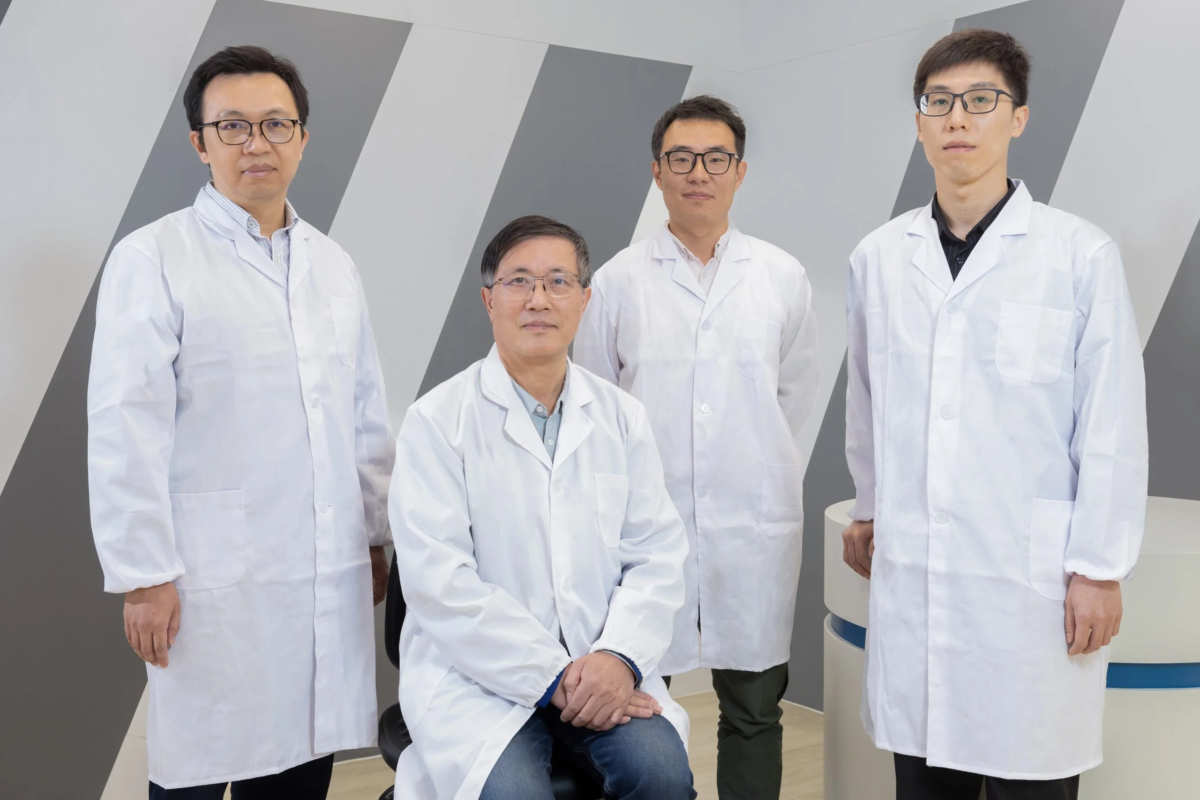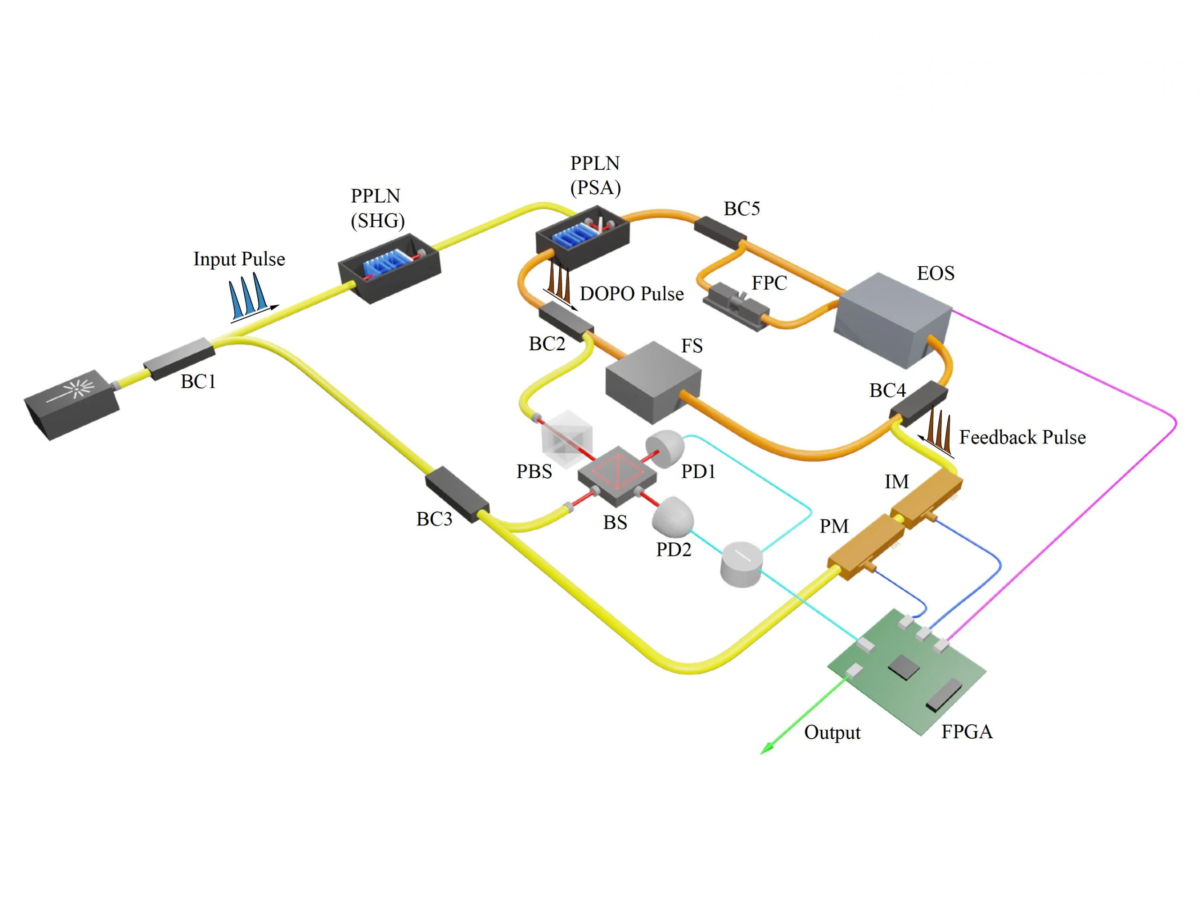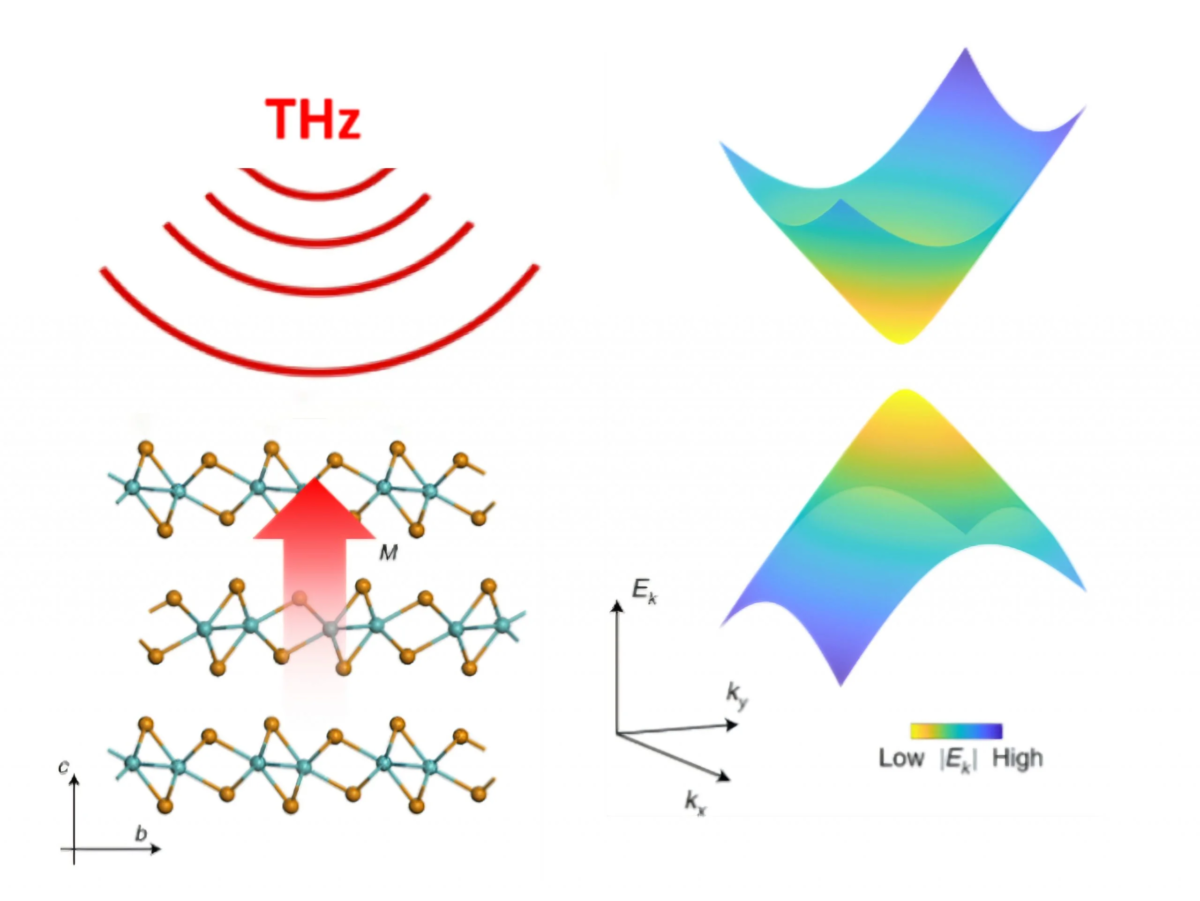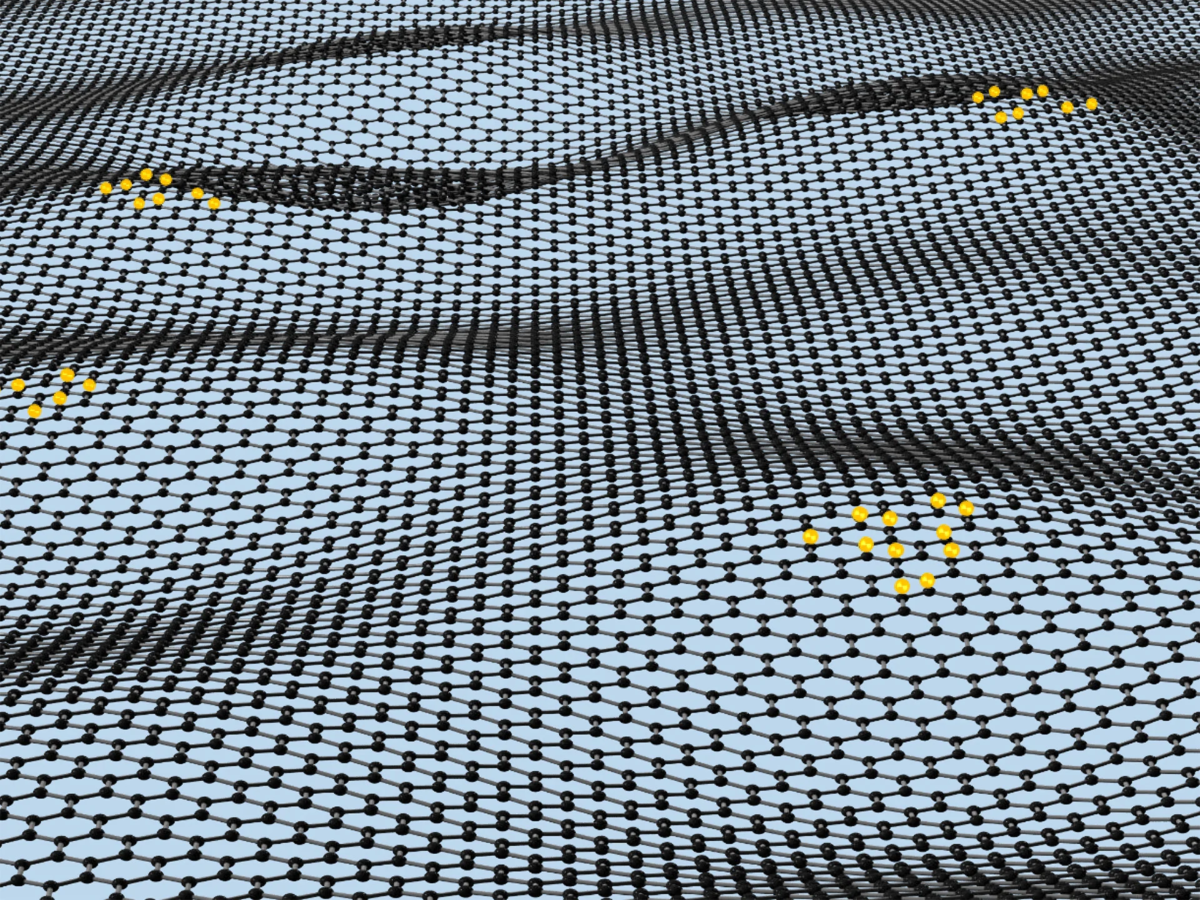A quantum is the smallest unit of things. Things at the quantum scale, such as clusters of atoms and subatomic particles, behave differently than they do in our everyday macroscopic world. Scientists are taking advantage of these differences to develop devices that can store, share, and compute information faster. At the Institute of Applied Physics and Materials Engineering (IAPME) of the University of Macau (UM), Chair Professor Tang Zikang, who is the director of IAPME, Associate Professor Ian Hou, Assistant Professor Lai Shen and Assistant Professor Sun Pengzhan have formed the Quantum Information Research Group. Together they are exploring new ways of processing information that use the principles of quantum mechanics, in the hope of advancing fields such as computing and communications technology.
Exploring the quantum realm
China’s 14th Five-Year Plan, which was released in 2021, sets out plans for a variety of nationwide science and technology initiatives with a focus on emerging fields such as quantum information science (QIS). In the United States, federal funding for quantum information research has grown significantly since the introduction of the National Quantum Initiative Act in 2018. Countries including Germany, Japan, and the United Kingdom have also developed strategies to promote quantum technology.
Researchers around the world are harnessing this trend with advanced technologies to develop quantum computing, one of the most important applications of QIS. Quantum computers can perform multiple computations simultaneously, unlike classical computers which can only perform one computation at a time. These novel computers store data in qubits, or quantum bits, which can represent not only 0 or 1, but also a unique ‘superposition’ state with different ratios, in which 0 and 1 exist at the same time.
In front of a whiteboard brimming with mathematical equations in his office, Prof Tang, a physicist who developed the world’s smallest single-walled carbon nanotubes, explains why researchers at UM are exploring quantum information science (QIS) processing with classical coherent light. ‘Quantum computing has limitless potential to perform computations to solve challenges that classical computers take years to solve or even cannot solve,’ he says. ‘As a result, quantum computing has become a subject of great interest worldwide. At UM, our team is striving to make breakthroughs in areas of global interest.’ To achieve this goal, the Quantum Information Research Group has been working on a brand-new materials system based on quantum information and computation, nonlinear quantum transport, and topological topics in solid-state theory, striving for cutting-edge discoveries.
To achieve this goal, Prof Tang and three other physicists from IAPME, namely Associate Professor Ian Hou, as well as Assistant Professors Lai Shen and Sun Pengzhan, have formed the Quantum Information Research Group. The group works on a brand-new materials system based on quantum information and computation, nonlinear quantum transport, and topological topics in solid-state theory, striving for cutting-edge discoveries.
Quantum computing with classical coherent light
Prof Ian, a scientist with extensive experience researching quantum information processing and quantum computation at UM, explains that the development of sophisticated, fully functional quantum computers still faces enormous challenges. ‘For example, a qubit state is extremely vulnerable and sensitive and can flip its state with the slightest change in temperature. It is often extremely costly to keep the temperature of qubits close to absolute zero when manipulating and studying them,’ he says.
Prof Ian adds that in the quantum world, one particle can be connected to another particle in a strange way, and whenever the state of one of the particles changes, the state of the other particle is automatically affected, regardless of the physical distance between them. ‘This phenomenon is known as “quantum entanglement”. Quantum algorithms usually require two particles to be stably entangled, which involves a complicated technical process,’ he says.
Faced with this reality, Prof Tang and Prof Ian have been exploring the use of classical coherent optical techniques to replace the use of qubits with macroscopic states of light, which are the properties of light that can be observed at a macroscopic level. Their research led to a breakthrough when they applied this method to a highly efficient quantum algorithm for integer factorisation, the process of decomposing a large integer into two prime numbers. ‘Many scientists believed that this algorithm could only be implemented through quantum entanglement, but we have proven that what people believe is not definitely true,’ says Prof Ian.
In essence, Prof Tang and Prof Ian have used two attributes of macroscopic light – polarisation, which indicates the direction of the light, and amplitude, which measures the strength of the vibration — to achieve the function of qubits. The researchers then ‘entangled’ these two attributes of a photon so that they mirror each other, as if they are two particles in quantum entanglement.
With Shor’s algorithm, a quantum algorithm, they seek to factorise integers using photons, without the need for low-temperature environments. ‘This is much cheaper and easier than entangling two particles to use this quantum algorithm specific by quantum mechanics,’ explains Prof Ian. ‘As many cryptographic methods require factorisation of large integers, the widespread use of quantum algorithms for this purpose could profoundly improve the security and convenience of information transmission, for example in banking transactions and private messages,’ Prof Ian says.
New materials for sensors in communications devices
QIS also involves studying potential materials for next-generation sensors. Communications devices such as mobile phones, cellular stations and satellites all contain sensors. Prof Lai, an expert on a physical phenomenon known as the ‘Hall effect’, explains, ‘Certain materials exhibit a distinct Hall effect when an alternating current electric field is applied in a specific crystal direction. By measuring this voltage, communications devices can detect the surrounding electromagnetic field. For example, a sensor in a mobile phone can identify nearby wireless communication electromagnetic signals by measuring the Hall voltage.’
In recent years, terahertz communication has become increasingly important in the development of 6G mobile communications networks. Terahertz detectors are essential components of these systems and play a key role in determining their potential applications. However, current terahertz detectors have some tough issues that need to be addressed. That is why there has been growing interest in materials that exhibit the ‘nonlinear Hall effect’, which are not affected by material scattering and other external factors. These materials are expected to improve the performance and reliability of future communications devices.
A research team of which Prof Lai was once a member found that a particular type of non-linear Hall effect is caused by a material property known as the ‘Berry connection polarisability tensor’. Since joining UM, he has continued to investigate this topic. ‘I am deepening my research on this type of non-linear Hall effect, in the hope that such findings will facilitate the development of sensors for quantum communications devices that can accurately detect and absorb nearby electromagnetic signals,’ he says.
Tiny tunnels for complex information
While most electronic devices transmit information via the flow of electrons, Prof Sun has pioneered the use of molecular ion flow to do so. ‘To transmit information, I have constructed some tiny tunnels using two-dimensional materials like graphene. These tunnels can selectively allow a single molecular ion, which serves as an information carrier, to pass through,’ explains Prof Sun.
Many experts believe that the laws of classical mechanics generally do not apply to objects at the quantum scale. However, an overseas research team with which Prof Sun once collaborated made an interesting discovery. The team found that the Kelvin equation, which describes the aggregation of fluids in tiny tubes, a phenomenon known as the ‘capillary action’, also holds in the sub-nanometre-scale tunnels they constructed. ‘At UM, I continue to investigate the physical properties inside these tiny tunnels. This study could result in techniques for precisely controlling the flow of molecular ions,’ says Prof Sun.
In addition, Prof Sun has been building ‘heterogeneous’ 2D tunnels in the nanometre range and even the smaller sub-nanometre range. ‘We can build tiny tunnels with various physical properties by combining different 2D crystals the same way we put Lego bricks together. The development of these tunnels will help us to develop new conceptual means of communications that can exchange very complicated information with molecular ions,’ he adds.
Quantum research for an intelligent society
QIS promises to revolutionise key technologies in areas such as communications and computing, which are important building blocks for a more intelligent society. Looking into the future, Prof Tang says, ‘Our institute is determined to increase collaboration with other universities and institutions for QIS research. We are not only committed to developing new technologies and exploring novel physical phenomena, but also expanding the practical applications of QIS.’
量子是物體的最小單位。在量子尺度(如原子簇或分子簇)的世界,量子物體的特性與在我們日常的宏觀物體大相逕庭。科學家正利用這些特異性,研發更快的信息儲存、計算和交換設備。在澳門大學應用物理及材料工程研究院,研究院院長湯子康講座教授、殷灝副教授、賴屾助理教授和孫鵬展助理教授組成「量子資訊研究組」,以量子力學的原理研發新的資訊處理方式,期望在計算和通訊科技等領域取得突破。
探索量子尺度的世界
2021年發佈的國家《十四五規劃綱要》指出,中國將在量子資訊等前沿領域,實施一批具有前瞻性、戰略性的國家重大科技項目。美國則自2018年《國家量子倡議法案》生效以來,大幅增加撥款予量子資訊研究。英國、日本、德國等國亦制訂了量子科技政策。
借助這些前沿技術的支持,世界各地均有專家研發量子計算(量子資訊研究中的一項關鍵應用)。普通電腦僅能一次進行一項計算。相較之下,量子電腦能夠同時進行多項計算,以量子比特為單位元儲存資訊,每個量子比特不僅可代表0或1,還能表現「0和1」不同比例的「疊加」狀態。
在辦公室內一塊寫滿數學圖示的白板前,曾研製出世界最細單壁納米碳管的物理學家的湯子康教授講解其團隊研究經典相干光束進行量子資訊處理的緣由:「量子計算潛力無限,能解決一般經典電腦耗費數十年才完成,或甚至無法解決的計算,成為各國爭相探索的研究課題。我們的團隊亦希望在世界關注的前沿研究領域有所突破。」因此,研究院組成「量子資訊研究組」,專攻量子資訊和計算、非線性量子傳輸,以及固態中拓撲學為基礎的全新材料體系,開拓創新成果。
因此,湯教授和三位研究院的物理學者殷灝副教授、賴屾助理教授和孫鵬展助理教授組成「量子資訊研究組」,專攻量子資訊和計算、非線性量子傳輸,以及固態中拓撲學為基礎的全新材料體系,開拓創新成果。
以經典相干光束作量子計算
殷教授在澳大長期研究量子資訊處理與量子計算。他說:「若要實現有完善程度及實際用途的量子計算,需克服諸多高度難問題,例如量子比特狀態非常脆弱敏感,溫度稍有變化便能改變其狀態。因此,在處理和研究量子比特時通常要保持接近絕對低溫,成本高昂。」
殷教授又說,在量子尺度的世界,一顆粒子能與另一顆粒子以奇特的方式相互聯繫,無論相隔多遠,只要影響其中一顆粒子,另一顆粒子的狀態即會自動改變,這種現象稱為「量子糾纏」。「量子演算法通常都需要將兩顆粒子穩定地『糾纏』起來,當中涉及複雜的高難度過程。」
針對這一難題,殷教授和湯教授探索運用經典相干光束技術,以宏觀光態(即光在宏觀層面可觀察和可測量的特性)取代量子比特,成功應用於一種高效的特許量子演算法,將一個大整數分解為兩個質數(即「整數分解」),這結果讓他們相當振奮。「許多科學家認為只有透過量子糾纏,才能使用這種演算法,但我們已經證實其實並非一定如此。」
湯教授和殷教授利用宏觀光的兩種特性(例如光束的「偏振」與「振幅」)來實現量子比特的功能。接著,他們將這兩種特性的狀態「糾纏」,使兩者呈現映射關係,如同兩顆粒子處於量子糾纏。
利用「Shor演算法」(一種量子演算法),團隊正嘗試利用相干光子實現整數分解,過程毋須使用低溫環境。殷教授說:「以這種方法使用量子演算法,其成本及複雜度遠低於進行量子力學規範的量子糾纏。由於很多加密技術都涉及大整數分解,如果能夠廣泛地使用量子演算法來作大整數分解,便能使銀行交易或私人通訊等資訊傳遞活動更安全和便利。」
通訊裝置傳感器的新材料
量子資訊研究亦涉及有潛力用於新一代傳感器的材料。目前,手機、移動通訊基站和衛星等通訊設備有眾多傳感器。研究「霍爾效應」多年的賴教授表示:「對於某些材料,在特定的晶體方向施加交流電場時,這些材料會形成特殊的『非線性霍爾效應』。通訊設備測量這種電壓,就能探測周圍電磁場的情況。例如,手機的傳感器透過測量霍爾電壓,便可識別周邊無線電磁波信號。」
近年來,太赫茲通訊在6G移動通訊網絡技術中的重要性日益突出。太赫茲探測器作為太赫茲通訊系統的核心器件,其性能決定了太赫茲系統的應用價值。目前的太赫茲探測器存在一些普遍的高難度問題。因此,不受材料散射及其它外部條件影響的「非線性霍爾效應」材料近年受到廣泛關注,有望提高未來通訊設備的性能和可靠性。
賴教授曾參與的研究團隊發現,其中一種非線性霍爾效應源於一種名為「貝裡連接極化張量」的材料特性。他表示:「我加入澳大後不斷繼續深究這種非線性霍爾效應,成果能應用於量子通訊設備的傳感器,使它們精確地探測及吸收附近的電磁波信號。
微小通道傳遞複雜資訊
一般電子產品運用電子的流動來交換信息。孫教授則以分子離子的流動達到相同目的。「我用石墨烯等二維晶體構造一種極微小的通道,這種通道能選擇性地允許單一分子離子通過,從而傳遞資訊。」
許多學者認為,經典物理原理大多無法適用於量子尺度的物體。但孫教授曾參與的海外研究團隊卻發現,在他們建造的亞納米級通道中,描述液體在微小管道內聚集(即「毛細管凝聚現象」)的「Kelvin方程」仍然有效。孫教授說:「我在澳大繼續瞭解這些微小通道內的物理特性,協助開發精準地控制分子離子流動的技術。」
此外,孫教授最近開始在納米尺度和更微細的次納米尺度下構建二維「異質」通道。「我們能像玩樂高積木般,以各種二維晶體組裝出有不同物理特性的通道,藉此進一步開發新概念通訊措施,以分子離子交換非常複雜的資訊。」
量子研究助構建智慧社會
量子資訊研究有望革新通訊和計算等領域的關鍵技術,將會對構建更智慧的社會起著革命性作用。展望未來,湯教授說:「我們的研究院正與其它大學和機構積極加緊合作推動量子資訊研究,包括探索新物理現象、開發新技術,拓寬和提升量子資訊研究成果的應用性。」

Quantum Information Research Group of the Institute of Applied Physics and Materials Engineering at UM – from Left: Prof Ian Hou, Prof Tang Zikang, Prof Sun Pengzhan, Prof Lai Shen 應用物理及材料工程研究院量子資訊研究組,左起:殷灝教授、湯子康教授、孫鵬展教授、賴屾教授

Prof Ian Hou's study involves using classical coherent light for quantum computing processing. 殷灝教授的研究涉及利用經典相干光束進行量子計算。他與其他澳大研究人員利用本圖所示的光學設置,借助量子力學原理執行一種演算法,檢測一種可用於加密電子簽名的密碼散列函數的弱點



